It’s that exciting time of year when seeds we planted in little pots are growing bigger by the day, and soon we’ll be able to move them outside to the garden. Maybe we’ve even direct-seeded some hardy varieties. But before we get too many vegetables in the ground, we might want to consider adding flowers to the plan!
Mix Flowers with Your Veggies
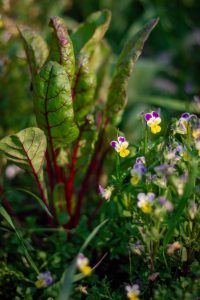
Chard and violas make a pretty combination planting
Not only will bright blossoms attract pollinators, they’ll also encourage beneficial insects that will prey on the pests that are trying to eat your vegetables. Try to include flowers with a wide range of blooming times, so there will be something blooming all the way up to the first frost. You’ll attract the widest range of helpful insects and birds by planting a variety of flower types as well. Here are some examples: flowers from the daisy family include black-eyed Susan, cosmos, marigold, zinnia, and sunflower. The mustard family has nasturtiums and sweet alyssum. And don’t forget the mint family with basil, sage, and mint.
Know Which Plants Should be Neighbors
When choosing flowers to mix in with your edible plants, some do better than others with certain vegetables. Not only will certain flowers attract the right kind of insects, but sometimes it helps to know which colors and shapes of blooms will add the best contrast and make your garden even more attractive! Here’s a list of common flowers and the vegetables to pair them with:
Alyssum – As these ground-hugging plants grow and spread, they’ll naturally fill in the spaces between chives, leeks, onions, and shallots. The pink and purple varieties will look stunning mixed with eggplant, purple basil, bush beans and sprouting broccoli. Try the white alyssum with dark green kale, bok choy, and beets.
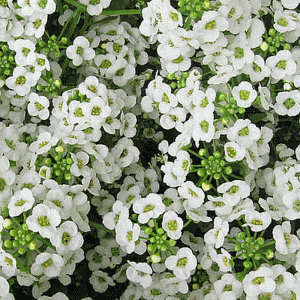
White Alyssum
Calendula – Look for the taller heirloom varieties. Plant with beets, broccoli, cabbage, carrots, lettuce, and kale. Calendula petals are also wonderful to use in tea and body care products.
Cosmos – All the colors of this flower will attract beneficials, so feel free to choose your favorite. If you let them go to seed you may have yellow finches flocking to your garden as well. Try a mix of red yellow and orange cosmos in front of tomatoes and okra, and near trellised beans and cucumbers.
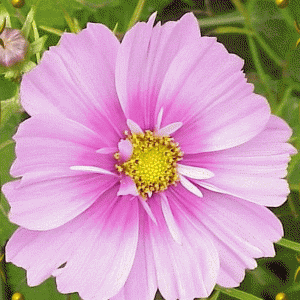
‘Daydream’ Cosmos
Echinacea – One of the best choices for attracting bees, and the beautiful purple flowers will add a punch of color. Since they’re perennials, you’ll want to give them an established spot where they won’t be disturbed. Try adding some at the end of a garden bed, or mixed in with other herbs like dill, fennel or sage.
Marigold – For blooms that last from spring through fall, marigold’s brilliant shades of orange, yellow and bronze can’t be beaten. The older varieties that reach 4 feet in height are perfect in front of trellises of climbing beans. Use the more compact types to create a border around peppers, or mix in with kale and other greens.
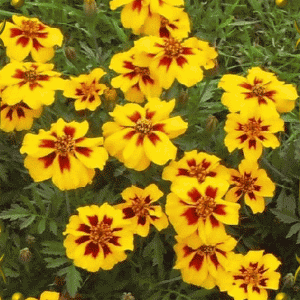
French Marigold
Sage – If you want to attract hummingbirds and bees, choose a non-edible variety with tall spikes of red or blue flowers like ‘Victoria’. All kinds of sage can be planted with okra, peppers, and tomatoes.
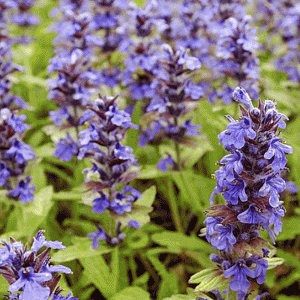
‘Azure Blue’ Sage
Sunflowers – Tall and cheerful, these plants will attract insects as well as provide edible seeds for you and the birds. Keep them in the back of the garden, behind zucchini plants or a bed of bush beans. The tallest varieties can be planted with a patch of corn, or behind a bed of winter squash.
Violas – Also known as Johnny-Jump-Ups, these darling purple flowers are always a favorite. They’re perfect for filling in between cabbages, surrounding a bed of mixed lettuces or filling containers placed throughout the garden.
Zinnia – These blooms will attract butterflies by the dozens, and they come in many colors and sizes. Try the dwarf varieties in a bed of chilies, or the tall pastel colors with artichokes or Brussels sprouts. You really can’t go wrong with zinnias, so feel free to combine them with any vegetable you like!
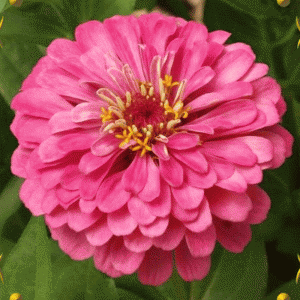
‘Luminosa’ Zinnia
Now that you’ve added flowers to your garden, it will be healthier and even more beautiful than ever before!
Copyright Everwilde Farms 2018

